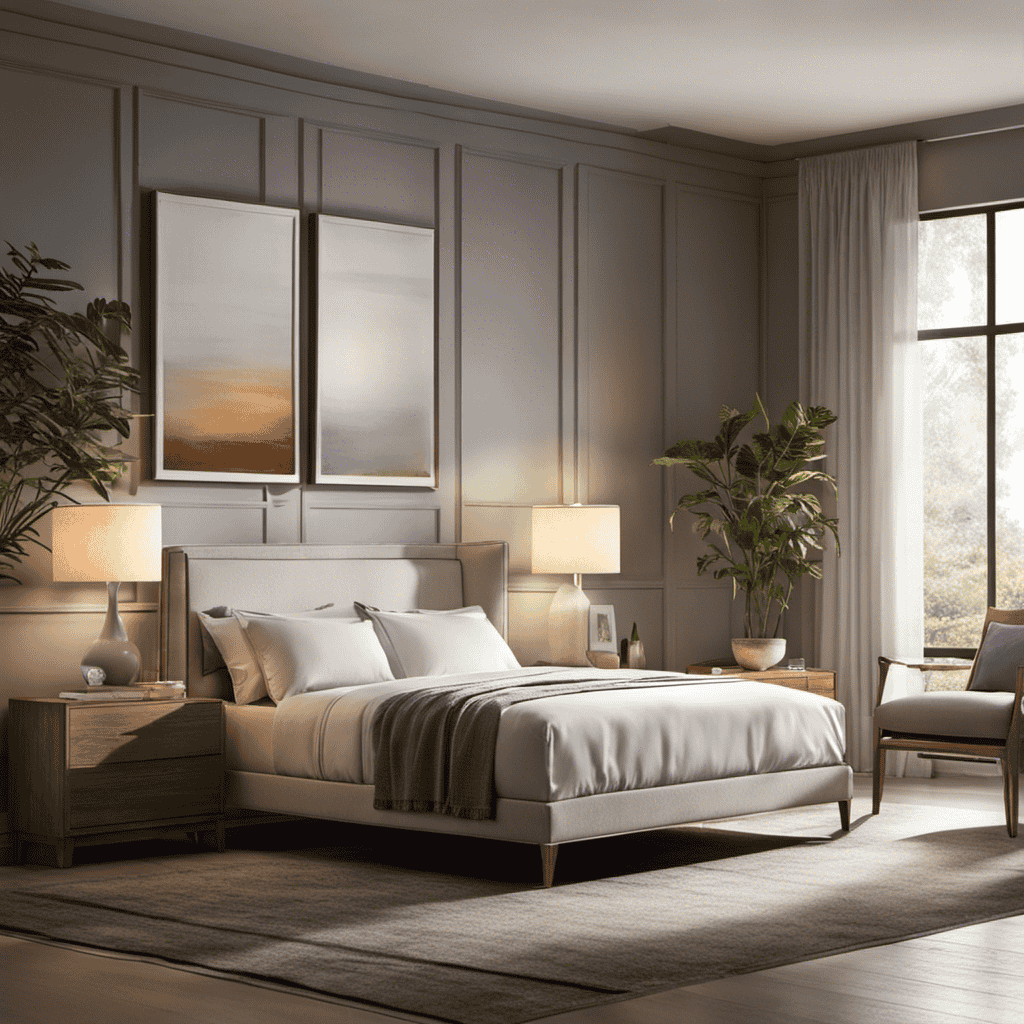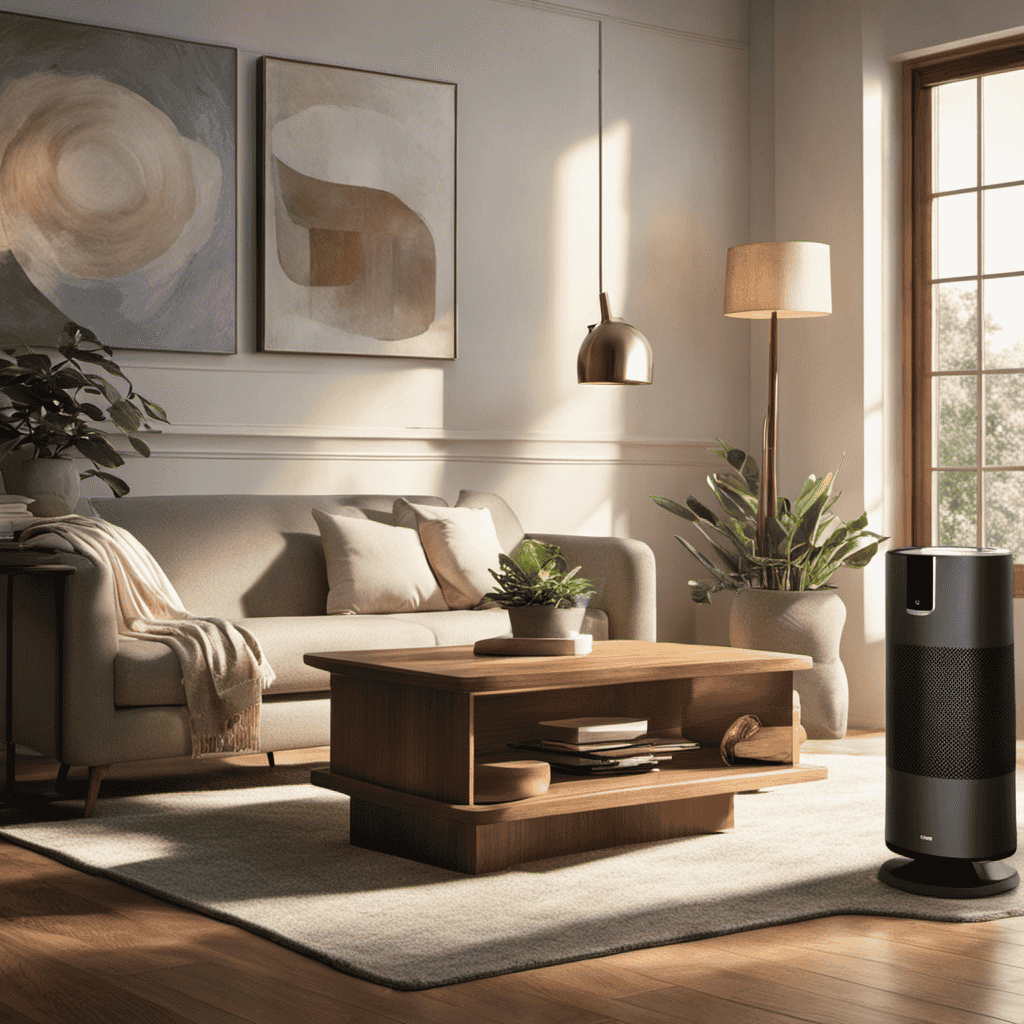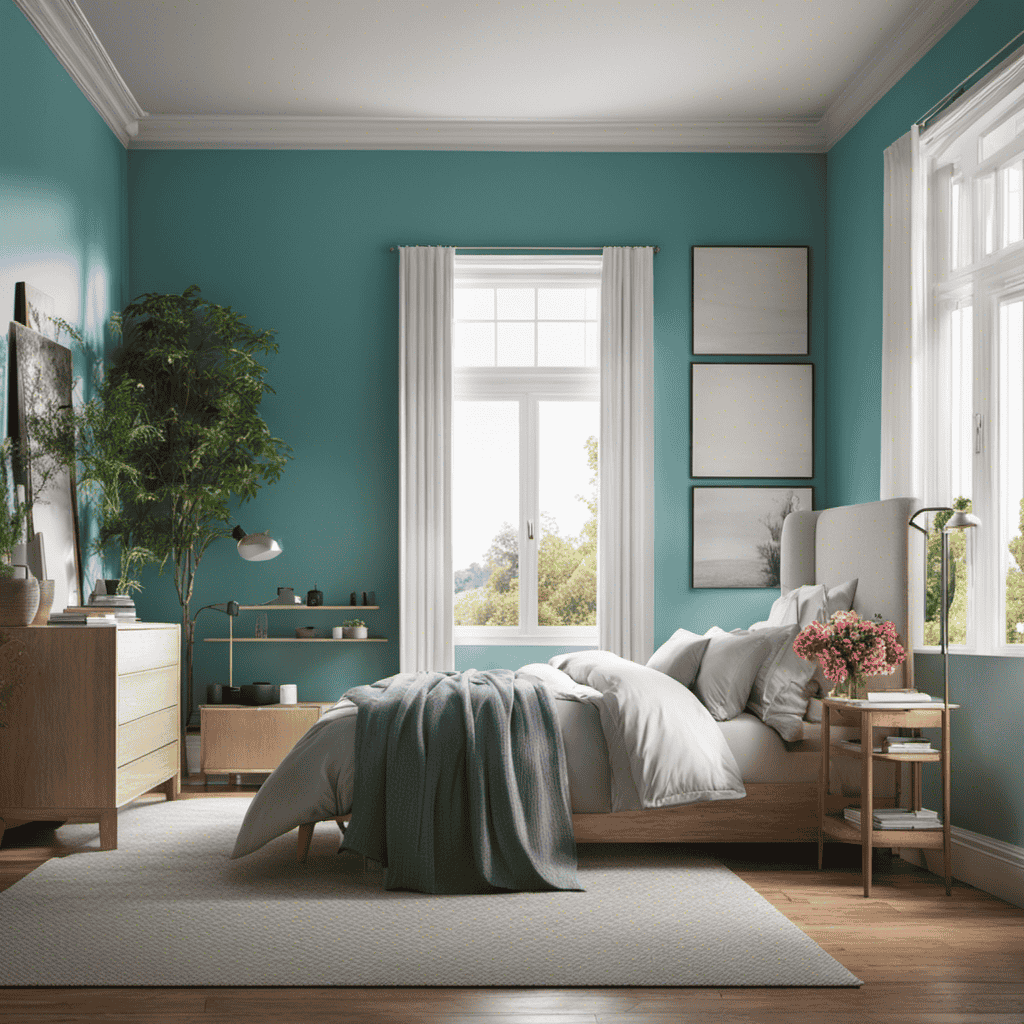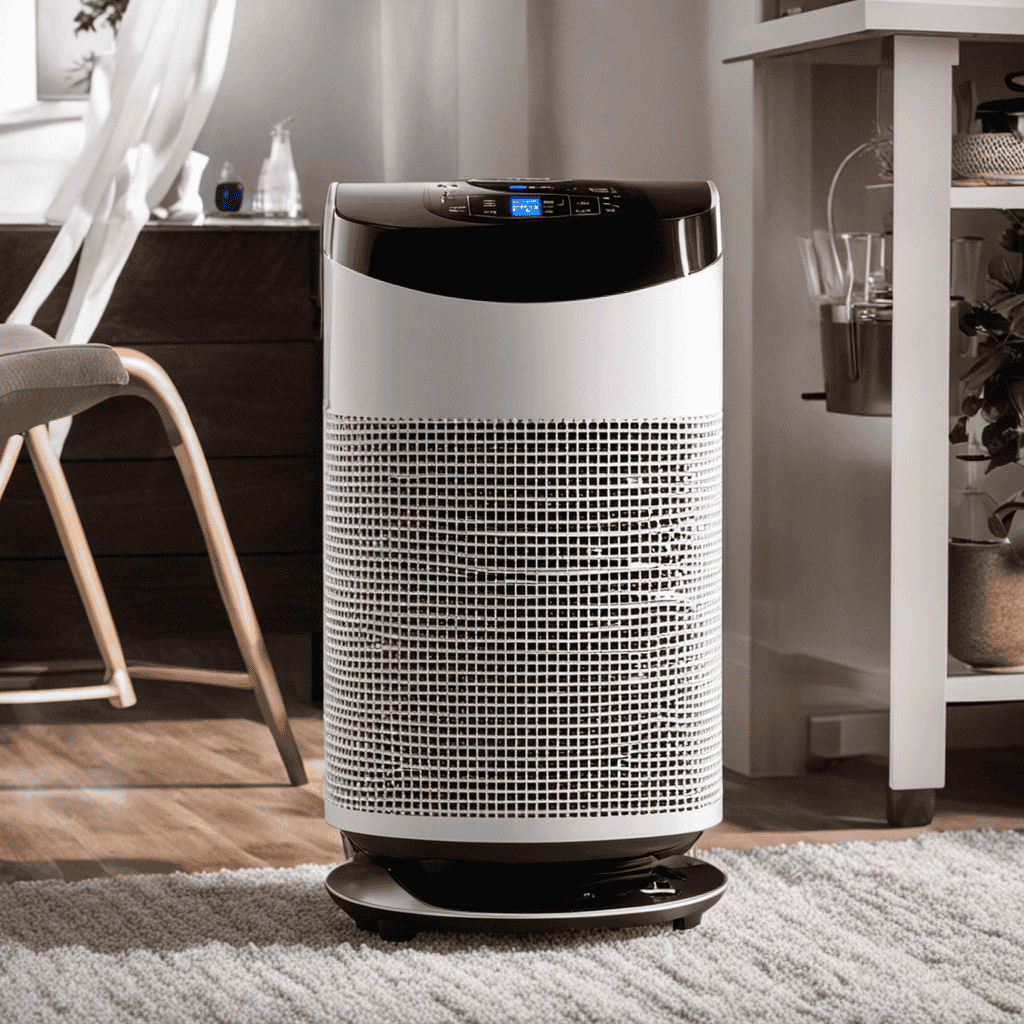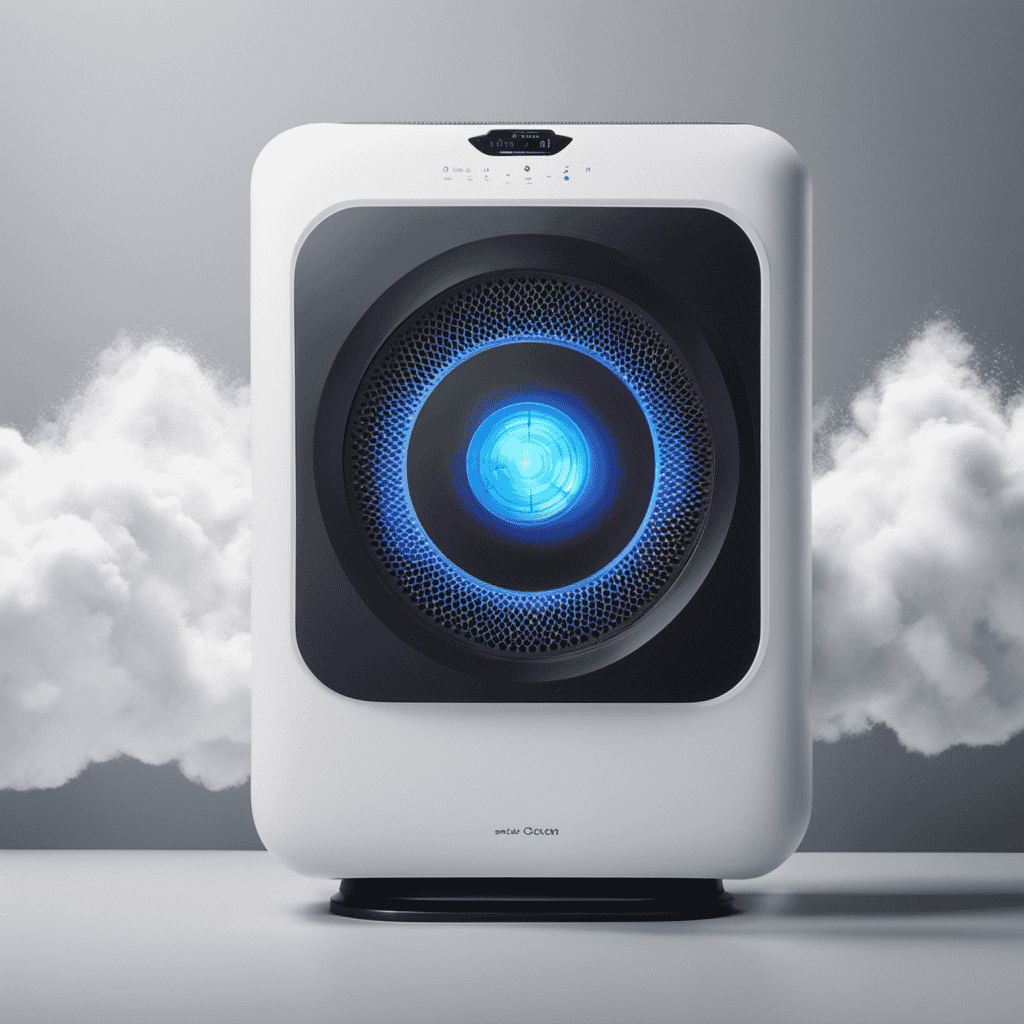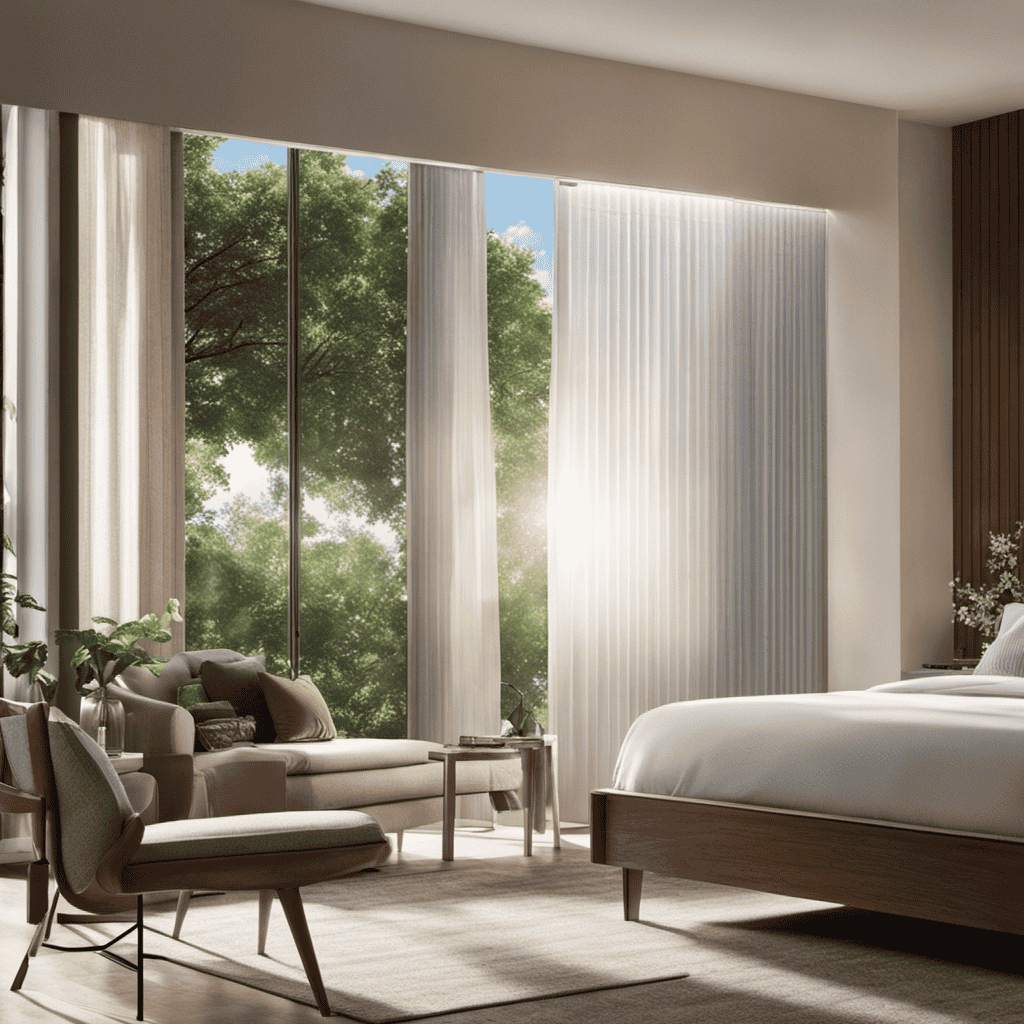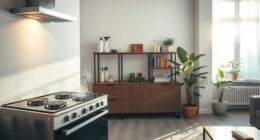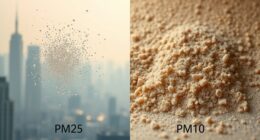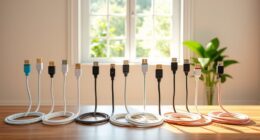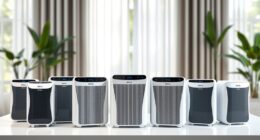I am shocked at how long I used to keep my air purifier running! As it turns out, there is a recommended usage time that ensures it works at its best.
In this article, I’ll dive into the factors to consider when determining how long to run your air purifier. We’ll explore the different types of air pollutants and their impact, as well as the health benefits of continuous usage.
Plus, I’ll share some tips for optimal air purifier usage. Get ready to breathe in cleaner, fresher air!
Key Takeaways
- Air purifiers should be run for at least 8 to 12 hours daily for optimal air quality.
- Energy consumption and cost should be considered when determining the usage time of an air purifier.
- The time it takes to purify the air depends on factors such as room size, air purifier type, and pollution level.
- Continuous usage of an air purifier can provide health benefits such as improved respiratory health, reduced risk of allergies, and elimination of unpleasant odors.
Factors to Consider
When deciding how long to leave your air purifier on, you should consider factors such as room size and air quality. These factors play a significant role in determining the optimal duration for using your air purifier.
Firstly, the size of the room is crucial because it directly influences the amount of air that needs to be filtered. Larger rooms will require more time for the air purifier to effectively clean the air.
Additionally, the air quality in your space is an important consideration. If you live in an area with high pollution levels or suffer from allergies, you may need to run your air purifier for longer periods to maintain a clean and healthy environment.
It is also essential to think about air purifier maintenance and energy consumption. Regular maintenance, such as cleaning or replacing filters, can ensure the optimal functioning of your air purifier. By following the manufacturer’s instructions, you can extend the lifespan of your device and maintain its efficiency.
Moreover, energy consumption is an important aspect to consider. While leaving your air purifier on all the time may provide constant purification, it can lead to increased energy usage and higher utility bills. Therefore, it is advisable to strike a balance between air purifier usage and energy conservation, based on your specific needs and circumstances.
Recommended Air Purifier Usage Time
When it comes to air purifiers, understanding the optimal operating hours is crucial for ensuring maximum efficiency. In this discussion, I will delve into the recommended usage time for air purifiers and the potential impact of extended use.
Optimal Purifier Operating Hours
To maximize the effectiveness of your air purifier, you should keep it running for at least 8 to 12 hours daily. This ensures that the air in your space is constantly being filtered, removing pollutants and improving air quality.
However, it’s important to consider the energy consumption and cost of continuous air purifier use. Here are some key factors to keep in mind:
-
Energy consumption: Running your air purifier for extended periods can increase your energy bill. Be mindful of this and consider running it during off-peak hours to save on costs.
-
Room size: The size of the room where the air purifier is being used will impact its operating hours. Larger rooms may require longer running times to achieve desired results.
-
Air quality: If you live in an area with poor air quality or have specific health concerns, you might need to run the purifier for longer periods to maintain clean air.
-
Maintenance: Regularly clean and replace filters to ensure optimal performance and efficiency.
Impact of Extended Use
Running your air purifier for extended periods can increase your energy bill, so it’s important to strike a balance between effectiveness and managing costs.
While it’s tempting to leave the purifier on all day to maintain optimal air quality, excessive usage can lead to higher energy consumption. Air purifiers work by continuously filtering the air, removing pollutants such as dust, pet dander, and allergens.
However, prolonged operation means that the purifier is constantly using energy, which can impact your electricity bill. To strike a balance, consider using the air purifier in high traffic areas or during peak pollution times, such as during allergy season or when cooking.
Additionally, investing in an energy-efficient model or setting a timer on your purifier can help you save on energy costs while still enjoying clean air.
Different Types of Air Pollutants and Their Impact
Air purifiers can help reduce the impact of various types of air pollutants. These pollutants can originate from a variety of sources, both indoors and outdoors. Understanding the different types of air pollutants and their impact on indoor air quality is essential in maintaining a healthy living environment.
Here are some examples of common air pollutants and their sources:
- Particulate Matter (PM): These are tiny particles suspended in the air, originating from sources such as dust, smoke, pollen, and pet dander.
- Volatile Organic Compounds (VOCs): These are chemicals emitted from various household products like cleaning agents, paints, and furniture. They can contribute to respiratory issues and other health problems.
- Carbon Monoxide (CO): This odorless and colorless gas is produced by the incomplete combustion of fuels like gas, oil, and wood. Exposure to high levels of CO can be life-threatening.
- Ozone (O3): While ozone in the upper atmosphere is beneficial, at ground level it can be harmful. It is produced by certain household appliances, as well as outdoor pollution.
By continuously running an air purifier, you can effectively reduce these pollutants and maintain indoor air quality standards. However, it is important to consider the specific type and size of the purifier, as well as the room size and pollutant levels, to determine the optimal duration for air purification.
Now, let’s explore how long it takes to purify the air and the factors that can affect this process.
How Long Does It Take to Purify the Air
In my previous section, I discussed the different types of air pollutants and their impact on our health. Now, let’s move on to the question of how long it takes to purify the air using an air purifier. The effectiveness of an air purifier and the speed at which it improves air quality depend on various factors such as the size of the room, the type of air purifier, and the level of air pollution.
To give you a better understanding, I have prepared a table that highlights the average time it takes for air purifiers to clean the air in different room sizes:
| Room Size | Air Purifier Type | Time to Improve Air Quality |
|---|---|---|
| Small (up to 150 sq. ft.) | HEPA Filter | 1-2 hours |
| Medium (150-300 sq. ft.) | Activated Carbon Filter | 2-4 hours |
| Large (300+ sq. ft.) | Ionic Air Purifier | 4-6 hours |
Please note that these are general estimates and the actual time may vary. It is also important to consider that continuous use of an air purifier is recommended for optimal air quality.
Now that we understand the time it takes for air purifiers to purify the air, let’s explore the health benefits of continuous air purifier use.
Health Benefits of Continuous Air Purifier Use
Using an air purifier regularly can greatly improve the quality of the air we breathe and provide numerous health benefits. Here are some of the benefits of continuous air purifier use:
-
Removal of airborne particles: Air purifiers are designed to capture and remove harmful particles from the air, such as dust, pollen, pet dander, and mold spores. By continuously running an air purifier, these particles can be effectively eliminated, reducing the risk of respiratory ailments and allergies.
-
Odor elimination: Air purifiers equipped with activated carbon filters can help eliminate unpleasant odors caused by cooking, pets, or smoke. Continuous usage ensures that these odors are constantly being filtered out, leaving the air fresh and clean.
-
Reduced exposure to volatile organic compounds (VOCs): VOCs are chemicals released by household products, furniture, and building materials. Extended usage of an air purifier helps minimize exposure to these harmful compounds, which can have adverse effects on health, including respiratory problems and even cancer.
-
Improved indoor air quality: By consistently running an air purifier, the indoor air quality is continuously monitored and improved. This is especially beneficial for individuals with respiratory conditions or weakened immune systems, as it helps create a healthier indoor environment.
To ensure the air purifier functions optimally and to minimize any extended usage risks, regular air purifier maintenance is necessary. This includes cleaning or replacing filters as recommended by the manufacturer, cleaning the unit itself, and periodically checking for any signs of damage. By following proper maintenance procedures, you can enjoy the health benefits of continuous air purifier use while prolonging the lifespan of your device.
Tips for Optimal Air Purifier Usage
To make sure your air purifier works effectively, it’s important to regularly clean or replace the filters as recommended. Proper air purifier maintenance not only ensures clean air but also helps optimize energy consumption.
When it comes to cleaning the filters, it’s important to follow the manufacturer’s instructions. Typically, this involves removing the filters and gently vacuuming or washing them to remove any accumulated dust or particles. Some filters may need to be replaced entirely, so it’s essential to check the recommended replacement schedule.
Regular maintenance not only extends the life of your air purifier but also ensures that it continues to effectively remove pollutants from the air.
Another aspect to consider is the energy consumption of your air purifier. Some models have energy-saving features, such as programmable timers or automatic shut-off functions. Taking advantage of these features can help reduce energy usage and lower your electricity bill.
Additionally, placing your air purifier in a central location within the room can help ensure optimal airflow and efficient operation.
Is There a Recommended Time for Leaving an Air Purifier on?
The recommended time for leaving an air purifier on depends on various factors such as the size of the room, the air quality, and the specific model of the air purifier. In general, it is suggested to run an air purifier continuously, but specific guidelines on how long to run air purifier may vary.
Frequently Asked Questions
Can I Leave My Air Purifier on All Day and Night?
Leaving an air purifier on all day and night can provide continuous benefits for improving indoor air quality. However, it is important to consider the potential energy consumption associated with prolonged use.
While air purifiers are generally designed to be energy efficient, running them constantly can lead to increased electricity usage and higher utility bills. It is recommended to use the air purifier as needed, considering factors such as the size of the room and the level of pollutants present.
Will Leaving the Air Purifier on for Longer Periods of Time Improve Its Effectiveness?
Leaving an air purifier on for extended periods can enhance its effectiveness in reducing indoor air pollution. To maximize efficiency, it’s recommended to keep the purifier running continuously, especially in high-traffic areas or during periods of increased pollution. This ensures that air contaminants are consistently filtered, maintaining a healthier environment.
However, it’s important to regularly clean and replace filters as per the manufacturer’s instructions to maintain optimal performance.
Are There Any Negative Effects of Leaving the Air Purifier on for Extended Periods of Time?
Leaving an air purifier on for extended periods of time can have potential health risks and increase energy consumption.
While air purifiers are designed to improve indoor air quality, prolonged exposure to the purified air can cause dryness or irritation in the respiratory system.
Additionally, running the purifier constantly can lead to higher energy bills.
It is recommended to use the air purifier when needed, such as during periods of high pollution or when experiencing allergies, rather than leaving it on continuously.
Can I Use Multiple Air Purifiers in Different Rooms Simultaneously?
Using multiple air purifiers in different rooms simultaneously is definitely worth the cost. It ensures that each room is free from pollutants and allergens, providing a healthier environment overall.
When choosing an air purifier for each room, consider the size of the room, the specific needs (e.g., allergies, pets), and the CADR (Clean Air Delivery Rate) of the purifier. This will help ensure that you have the right purifier to effectively clean the air in each room.
Is It Necessary to Run the Air Purifier on the Highest Fan Speed for Optimal Results?
Running an air purifier on the highest fan speed may not be necessary for optimal results. In fact, most air purifiers are designed to effectively purify the air even at lower fan speeds.
Running the purifier at a minimum fan speed can still provide efficient air purification while reducing energy consumption. It’s important to consider the energy implications of running the purifier at high fan speeds, as it may consume more electricity.
Conclusion
In conclusion, determining how long to leave an air purifier on depends on various factors such as the size of the room, the level of air pollution, and the specific needs of individuals.
While it is recommended to keep the air purifier running continuously for maximum effectiveness, it is important to consider energy consumption and cost implications.
By understanding the different types of air pollutants and their impact, users can make informed decisions about air purifier usage.
Ultimately, the question remains: How much clean and fresh air is worth it to you?
